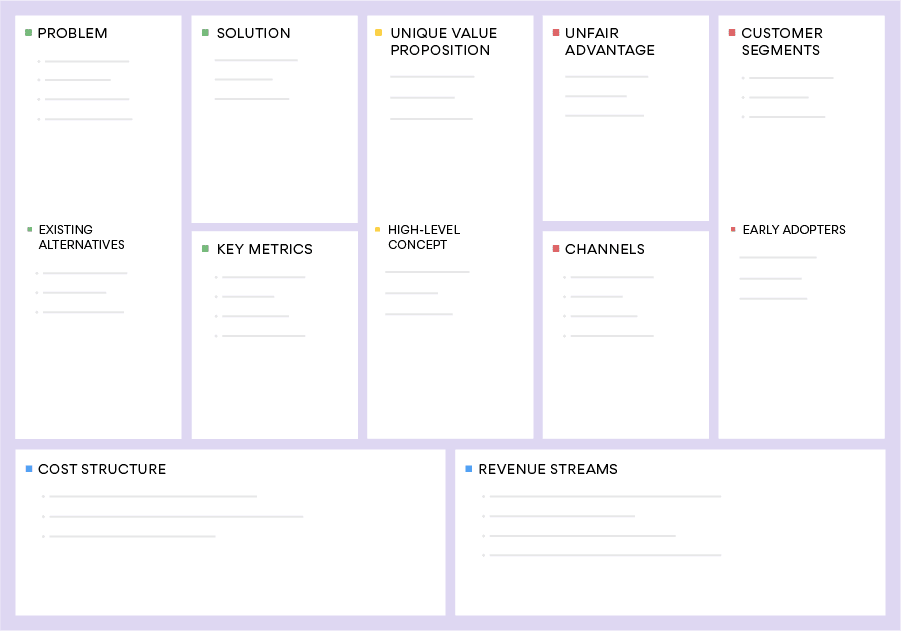🌎 Upmetrics is now available in
English
Français
Deutsch
Español
Italian
Portuguese
🌎 Upmetrics is now available in
English
Français
Deutsch
Español
Italian
Portuguese

The Lean Canvas is a version of the business model canvas and it is specially designed for StartUps and Entrepreneurs. The Lean Canvas focuses on addressing broad customer problems, solutions, key metrics, competitive advantages and delivering them to customer segments through a unique value proposition.
It is also called a one-page business plan template. It was adapted from Alex Osterwalder’s Business Model Canvas by Ash Maurya and optimized for the Lean Startup methodology with an emphasis on finding customer problems worth solving — specifically by building a solid foundation on the customer, problem, and solution assumptions before anything else. Lean Canvas promises an actionable and entrepreneur-focused business plan. It focuses on problems, solutions, key metrics, and competitive advantages.
Ash Maurya has explained the customer-centric approach about using the Lean Canvas as follow (You need to follow sequence) :
As this canvas is targeted at StartUps and the early adopters that first need to be reached, you have to outline an identifiable early adopter group that is part of the overall customer segment you think you should be targeting. This is in all canvases, but in this variant narrowed down. While writing this section you also have to consider writing the Problem section, because the “Problem-Customer” pair usually drives the rest of the canvas which is why you should tackle them together.
Along with the Customer-Segment section you need to describe the Problem section. The focus in Lean StartUps and in this canvas is identifying problems worth solving. In this section, you list the three main problems you intend to solve. This element was added to address the nature of startups; ‘most startups fail, not because they fail to build what they set out to build, but because they waste time, money, and effort building the wrong product.’
Dead-center in the Lean Canvas is a box for your Unique Value Proposition (UVP). This is one of the most important boxes on the canvas and also the hardest to get right. Your compelling promise or offer that is solving the number 1 problem, includes a finished story benefit value after a job done. This element is included in all canvases.
This is how you intend to deliver value. The solution is what most entrepreneurs and product developers are most passionate about. You are now ready to tackle solution possibilities. As all you have are untested hypotheses, I don’t recommend getting carried away with fully defining a solution just yet. Rather simply sketch out the top features or capabilities next to each problem. Bind a solution to your problem as late as possible.
The good news is that following a “Customer Discovery/Interview” process forces you to build a path to customers early. Unfortunately, unless you are in a direct sales business, that path may not scale beyond Problem/Solution Fit. In short describe your Marketing Strategies, Pricing Strategies, and any other strategy that leads you towards your customers.
Describe fixed, variable, and direct costs associated with your StartUp. You can also Calculate your BreakEven point put it here.
How do you make money? List your sources of revenue.
Find the key number that tells you how your business is doing in real-time before you get the sales report.
This is usually the hardest section to fill which is why I leave it for last. Most founders list things as competitive advantages that really aren’t. A real unfair advantage is something that cannot be easily copied or bought. You may initially have to leave this box blank but it’s here to have you really think about how you can make yourself different and make your difference matter.
This is usually the hardest section to fill which is why I leave it for last. Most founders list things as competitive advantages that really aren’t. A real unfair advantage is something that cannot be easily copied or bought. You may initially have to leave this box blank but it’s here to have you really think about how you can make yourself different and make your difference matter.

Capture Your Business Model on One Page